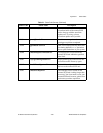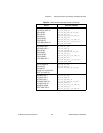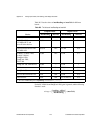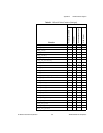
Appendix B Analog Input Channel, Gain Settings, and Voltage Calculation
NI-DAQ FRM for PC Compatibles B-4
©
National Instruments Corporation
Internal Channel constants are defined in the following header files:
• C programmers—
NIDAQCNS.H (DATAACQ.H
for LabWindows/CVI)
• BASIC programmers—
NIDAQCNS.INC (Visual Basic for Windows
programmers should refer to the Programming Language
Considerations section in Chapter 1, Using the NI-DAQ Functions, for
more information.)
• Pascal programmers—
NIDAQCNS.PAS
Note When the channel is ND_INT_DEV_TEMP, you can compute the temperature from
the retrieved voltage by applying the following formulas:
For VXI MIOs:
For all other supported E series devices:
Table B-3.
Internal Channel Purposes for Analog Input Devices
Internal Channel Purpose
ND_INT_AI_GND
Analog Input Channels Offset
ND_INT_AO_GND_VS_AI_GND
Ground Differential
ND_INT_AO_CH_0
Analog Output Channel 0 Offset/Linearity
ND_INT_AO_CH_1
Analog Output Channel 1 Offset/Linearity
ND_INT_CM_REF_5V
Analog Input Channels Offset
ND_INT_REF_5V
Analog Input Channels Gain
ND_INT_AO_CH_0_VS_REF_5V
Analog Output Channel 0 Gain
ND_INT_AO_CH_1_VS_REF_5V
Analog Output Channel 1 Gain
ND_INT_AO_CH_1_VS_AO_CH_0
Analog Output Channel 1 vs Analog Output Channel 0
ND_INT_DEV_TEMP
Device Temperature
T
°
C
()
Voltage 100
×()
32–
()
59
⁄×
=
T
°
C
()
Voltage 100
×()
50–=


















